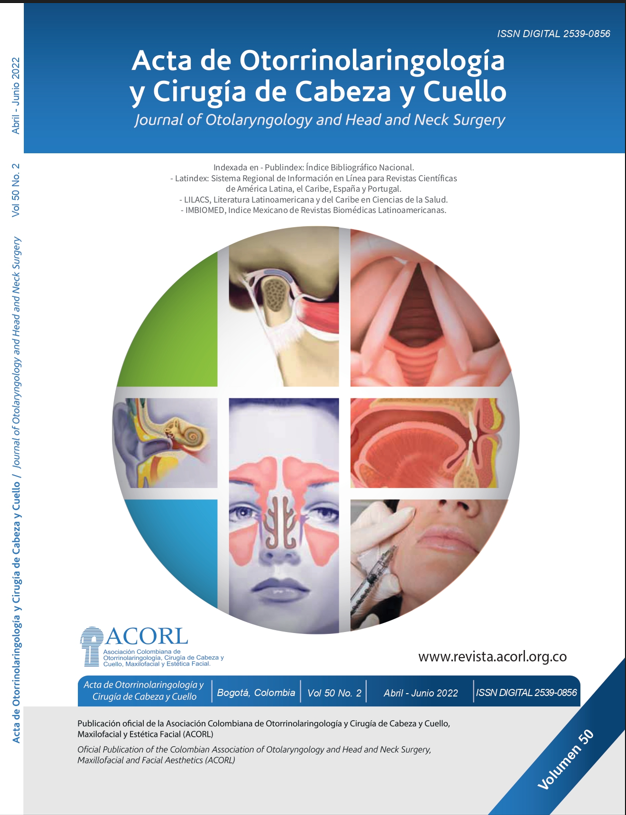Concordancia de la clasificación TI-RADS y el sistema Bethesda para detectar malignidad en pacientes con nódulo tiroideo
Contenido principal del artículo
Resumen
Introducción: evaluar la concordancia de la clasificación TI-RADS (Thyroid Imaging Reporting and Data System) y el sistema Bethesda para detectar malignidad en pacientes con nódulo tiroideo. Material y métodos: mediante un estudio observacional, retrospectivo y transversal en 90 pacientes con diagnóstico de nódulo tiroideo a los que se les realizó un ultrasonido de cuello, un estudio histopatológico definitivo y se les aplicó las escalas TI-RADS y Bethesda durante su abordaje desde julio del 2018 hasta noviembre de 2020. Resultados: se encontró una predominancia del sexo femenino, una sensibilidad del 43,6 % y una especificidad del 94,2 % en la clasificación de TI-RADS. Respecto a la clasificación de Bethesda obtuvimos una sensibilidad del 94,5 % y una especificidad del 51,4 %. Como resultado, se obtuvo una concordancia baja entre las dos pruebas. Discusión: de acuerdo con los resultados obtenidos en nuestro estudio pudimos constatar que los pacientes con nódulo tiroideo se ven beneficiados al realizar un abordaje adecuado que incluya un ultrasonido (USG) Doppler de cuello realizado por un profesional con entrenamiento, además de la realización de una biopsia por aspiración con aguja fina (BAAF) en los casos en que estén bien indicados. La prueba de concordancia fue baja, por tanto, consideramos necesario el uso de ambas pruebas diagnósticas dentro de la práctica clínica. Conclusión: el correcto uso de la clasificación TI-RADS para identificar las características de un nódulo tiroideo permite diferenciar de forma confiable a los pacientes que ameritan someterse a una BAAF frente a los que no la requieren.
Detalles del artículo
Sección

Esta obra está bajo una licencia internacional Creative Commons Atribución-CompartirIgual 4.0.
Este artículo es publicado por la Revista Acta de Otorrinolaringología & Cirugía de Cabeza y Cuello.
Este es un artículo de acceso abierto, distribuido bajo los términos de la LicenciaCreativeCommons Atribución-CompartirIgual 4.0 Internacional.( http://creativecommons.org/licenses/by-sa/4.0/), que permite el uso no comercial, distribución y reproducción en cualquier medio, siempre que la obra original sea debidamente citada.
eISSN: 2539-0856
ISSN: 0120-8411
Cómo citar
Referencias
1. Grani G, Lamartina L, Ascoli V, Bosco D, Biffoni M, Giacomelli L, et al. Reducing the Number of Unnecessary Thyroid Biopsies While Improving Diagnostic Accuracy: Toward the “Right” TIRADS. J Clin Endocrinol Metab. 2019;104(1):95-102. doi: 10.1210/jc.2018-01674.
2. Russ G, Bonnema SJ, Erdogan MF, Durante C, Ngu R, Leenhardt L. European Thyroid Association Guidelines for Ultrasound Malignancy Risk Stratification of Thyroid Nodules in Adults: The EU-TIRADS. Eur Thyroid J. 2017;6(5):225-237. doi: 10.1159/000478927.
3. Vargas-Uricoechea H, Meza-Cabrera I, Herrera-Chaparro J. Concordance between the TIRADS ultrasound criteria and the BETHESDA cytology criteria on the nontoxic thyroid nodule. Thyroid Res. 2017;10:1. doi: 10.1186/s13044-017-0037-2.
4. Zhuang Y, Li C, Hua Z, Chen K, Lin JL. A novel TIRADS of US classification. Biomed Eng Online. 2018;17(1):82. doi: 10.1186/s12938-018-0507-3.
5. Skowronska A, Milczarek-Banach J, Wiechno W, Chudzinski W, Zach M, Mazurkiewicz M, et al. Accuracy of the European Thyroid Imaging Reporting and Data System (EU-TIRADS) in the valuation of thyroid nodule malignancy in reference to the post-surgery histological results. Pol J Radiol. 2018;83:e579-e586. doi: 10.5114/pjr.2018.81556.
6. Gao L, Xi X, Jiang Y, Yang X, Wang Y, Zhu S, et al. Comparison among TIRADS (ACR TI-RADS and KWAK- TI-RADS) and 2015 ATA Guidelines in the diagnostic efficiency of thyroid nodules. Endocrine. 2019;64(1):90-96. doi: 10.1007/s12020-019-01843-x.
7. Wu XL, Du JR, Wang H, Jin CX, Sui GQ, Yang DY, et al. Comparison and preliminary discussion of the reasons for the differences in diagnostic performance and unnecessary FNA biopsies between the ACR TIRADS and 2015 ATA guidelines. Endocrine. 2019;65(1):121-131. doi: 10.1007/s12020-019-01886-0.
8. Jin ZQ, Yu HZ, Mo CJ, Su RQ. Clinical Study of the Prediction of Malignancy in Thyroid Nodules: Modified Score versus 2017 American College of Radiology’s Thyroid Imaging Reporting and Data System Ultrasound Lexicon. Ultrasound Med Biol. 2019;45(7):1627-1637. doi: 10.1016/j.ultrasmedbio.2019.03.014.
9. Trimboli P, Ngu R, Royer B, Giovanella L, Bigorgne C, Simo R, et al. A multicentre validation study for the EU-TIRADS using histological diagnosis as a gold standard. Clin Endocrinol (Oxf). 2019;91(2):340-347. doi: 10.1111/cen.13997.
10. Singaporewalla RM, Hwee J, Lang TU, Desai V. Clinico-pathological Correlation of Thyroid Nodule Ultrasound and Cytology Using the TIRADS and Bethesda Classifications. World J Surg. 2017;41(7):1807-1811. doi: 10.1007/s00268-017-3919-5.
11. Mistry R, Hillyar C, Nibber A, Sooriyamoorthy T, Kumar N. Ultrasound Classification of Thyroid Nodules: A Systematic Review. Cureus. 2020;12(3):e7239. doi: 10.7759/cureus.7239





